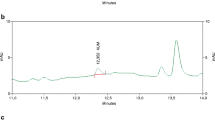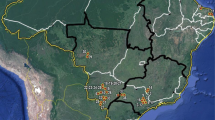Abstract
Fifty honey samples from Virginia USA were analyzed for the presence of fluvalinate and coumaphos residues. Samples were collected from hives and from bottled honey provided by beekeepers. No coumaphos or fluvalinate residues above the limit of quantification (0.05 mg/kg) were detected in any of the samples, although trace levels (<0.05 mg/kg) of coumaphos were detected in three samples from hives and trace levels of fluvalinate were found in one hive sample. No residues were detected in any of the bottled honey samples and none of the samples exceeded the US EPA tolerance levels for either miticide.


Similar content being viewed by others
References
Adamczyk S, Lázaro R, Pérez-Arquillué C, Herrera A (2007) Determination of synthetic acaricides residues in beeswax by high-performance liquid chromatography with photodiode array detector. Anal Chim Acta 581:95–101
Aysal P, Ambrus A, Lehotay SJ, Cannavan A (2007) Validation of an efficient method for the determination of pesticide residues in fruits and vegetables using ethyl acetate for extraction. J Environ Sci Health Pt B 42:481–490
Bogdanov S (2005) Contaminants of bee products. Apidologie 37:1–18
Bogdanov S, Kilchenmann V, Imdorf A (1998) Acaricide residues in some bee products. J Apic Res 37:57–67
Burley LM, Fell RD, Saacke RG (2008) Survival of honey bee (Hymenoptera: Apidae) spermatozoa incubated at room temperature from drones exposed to miticides. J Econ Entomol 101:1081–1087
Codex Alimentarius (1993) FAO/WHO Food Standards, Guidelines on Good Laboratory Practice in Residue Analysis, CAC/GL 40-1993, Rev 1-2003, 1–36
Eischen FA (1995) Varroa resistance to fluvalinate. American Bee J 135:815–816
Elzen PJ, Eischen FA, Baxter JR, Elzen GW, Wilson WT (1999) Detection of resistance in US Varroa jacobsoni Oud. (Mesostigmata: Varroidae) to the acaricide fluvalinate. Apidologie 30:13–17
Fell RD, Tignor K (2001) Miticide effects on the reproductive physiology of queens and drones. American Bee J 141:888–889
Garcia M, Fernández M, Herrero C, Melgar M (1996) Acaricide residue determination in honey. Bull Environ Contam Toxicol 56:881–887
Haarmann T, Spivak M, Weaver D, Weaver B, Glenn T (2002) Effects of fluvalinate and coumaphos on queen honey bees (Hymenoptera: Apidae) in two commercial queen rearing operations. J Econ Entomol 95:28–35
Karazafiris E, Tananaki C, Menkissoglu-Spiroudi U, Thrasyvoulou A (2008) Residue distribution of the acaricide coumaphos in honey following application of a new slow-release formulation. Pest Manage Sci 64:165–171
Kochansky J, Wilzer K, Feldlaufer M (2001) Comparison of the transfer of coumaphos from beeswax into syrup and honey. Apidologie 32:119–125
Sammatara D, Gerson U, Needham G (2000) Parasitic mites of honey bees: life history, implications, and impact. Annu Rev Entomol 45:519–548
Tsigouri AD, Menkissoglu-Spiroudi U, Thrasyvoulou A, Diamantidis G (2004) Fluvalinate residues in honey and beeswax after different colony treatments. Bull Environ Contam Toxicol 72:975–982
Wallner K (1995) The use of varroacides and their influence on the quality of bee products. Am Bee J 12:817–821
Wallner K (1999) Varroacides and their residues in bee products. Apidologie 30:235–248
Acknowledgments
The authors thank Derek Monthei for laboratory assistance and Nancy Adamson for assistance in collecting hive samples. This work was supported by a grant from the US EPA on Reduced Pesticide Use in Bee Hives (X8-973376).
Author information
Authors and Affiliations
Corresponding author
Rights and permissions
About this article
Cite this article
Fell, R.D., Cobb, J.M. Miticide Residues in Virginia Honeys. Bull Environ Contam Toxicol 83, 822–827 (2009). https://doi.org/10.1007/s00128-009-9806-5
Received:
Accepted:
Published:
Issue Date:
DOI: https://doi.org/10.1007/s00128-009-9806-5




